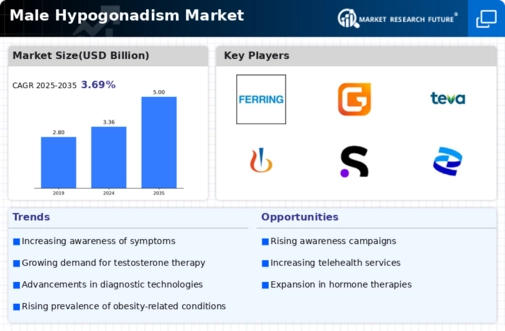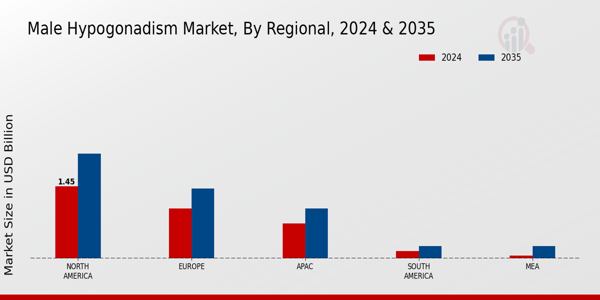Aging Population
The demographic shift towards an aging population is a crucial factor propelling the Global Male Hypogonadism Market Industry. As men age, the likelihood of experiencing low testosterone levels increases, leading to a higher prevalence of hypogonadism. This trend is particularly pronounced in developed countries where life expectancy is rising. Consequently, healthcare providers are increasingly focusing on screening and treating older men for hypogonadism. This growing patient population is expected to contribute to a compound annual growth rate (CAGR) of 3.68% from 2025 to 2035, underscoring the market's potential for sustained growth in the coming years.
Market Growth Projections
The Global Male Hypogonadism Market Industry is projected to experience substantial growth over the next decade. With an expected market value of 3.36 USD Billion in 2024, the industry is anticipated to expand significantly, reaching 5 USD Billion by 2035. This growth trajectory suggests a compound annual growth rate (CAGR) of 3.68% from 2025 to 2035. Such projections reflect the increasing recognition of male hypogonadism as a critical health issue, alongside advancements in treatment options and rising awareness among the male population. The market's expansion is indicative of the evolving landscape of men's health and the importance of addressing hormonal deficiencies.
Advancements in Treatment Options
Innovations in treatment modalities for male hypogonadism are significantly influencing the Global Male Hypogonadism Market Industry. The development of novel testosterone replacement therapies, including transdermal patches, gels, and long-acting injections, has broadened the therapeutic landscape. These advancements not only enhance patient compliance but also improve treatment efficacy. As a result, the market is expected to grow, with projections indicating a value of 5 USD Billion by 2035. The introduction of personalized medicine approaches may further optimize treatment outcomes, thereby attracting more patients to seek therapy and driving market expansion.
Rising Incidence of Chronic Diseases
The escalating incidence of chronic diseases such as obesity, diabetes, and metabolic syndrome is influencing the Global Male Hypogonadism Market Industry. These conditions are often associated with hormonal imbalances, including low testosterone levels, thereby increasing the risk of hypogonadism among affected individuals. As healthcare systems prioritize the management of these comorbidities, the demand for testosterone replacement therapies is likely to rise. This trend not only highlights the interconnectedness of various health issues but also suggests a growing market potential, as more patients seek treatment for both chronic diseases and associated hormonal deficiencies.
Increasing Awareness of Male Hypogonadism
The rising awareness surrounding male hypogonadism is a pivotal driver for the Global Male Hypogonadism Market Industry. Educational campaigns and initiatives by healthcare organizations have led to improved recognition of symptoms and the importance of testosterone levels. This heightened awareness encourages men to seek medical advice, thereby increasing diagnosis rates. As a result, the market is projected to reach 3.36 USD Billion in 2024, reflecting the growing demand for testosterone replacement therapies and associated treatments. Furthermore, as more men become informed about the condition, the market is likely to expand significantly, contributing to the overall growth of the industry.
Regulatory Support for Testosterone Therapies
Regulatory bodies are increasingly providing support for testosterone therapies, which is a significant driver for the Global Male Hypogonadism Market Industry. Guidelines and recommendations from health authorities encourage the diagnosis and treatment of hypogonadism, thereby facilitating patient access to necessary therapies. This regulatory backing is crucial in promoting awareness and acceptance of testosterone replacement therapies among healthcare providers and patients alike. As a result, the market is poised for growth, with projections indicating a value of 5 USD Billion by 2035, as more individuals receive appropriate treatment for their condition.























